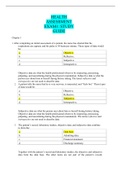Class notes
Lecture 11: Assessment of dementia (Neuropsychology of ageing)
- Course
- Institution
This lecture contains all the information from the eleventh lecture of the course Neuropsychology of Ageing at the VU. The summary is supplemented with pictures from the slides and extensive notes from the professor.
[Show more]












